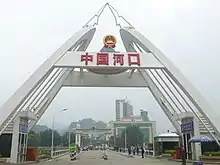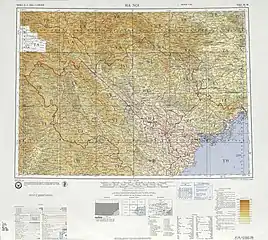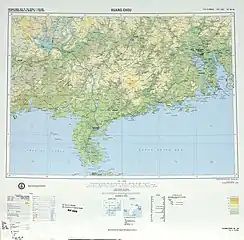China–Vietnam border
The China–Vietnam border is the international boundary between China and Vietnam, consisting of a 1,297 km (806 m) terrestrial border stretching from the tripoint with Laos in the west to the Gulf of Tonkin coast in the east, and a maritime border in the Gulf of Tonkin and South China Sea.[1]

While disputes over the terrestrial border have been settled with the signing of a land boundary treaty between the two countries, the maritime border is currently been undefined due to disputes over the ownership of territorial waters and islands, including over the Spratly and Paracel Islands.[2][1]
Description

The terrestrial border begins in the west at from the China-Laos-Vietnam tripoint at the Shiceng Dashan peak.[3] It then proceeds overland in a broadly eastwards direction, albeit in a highly irregular zig-zag pattern, predominantly through isolated mountainous areas inhabited by ethnic minorities.[4] In places rivers are utilised for short sections, such as the Lixian River, Red River, Nanxi, Sông Gâm, Song Chay and Jin Jiang. In the far east the border reaches the mouth of the Beilun/Ka Long River near the Chinese city of Dongxing and the Vietnamese city of Móng Cái, following the river through a marshland out to the Gulf of Tonkin.[4]
History
Ancient
The border region has a long history. China under the Han dynasty had established control over Nam Việt (northern Vietnam) by the early 1st century BC.[4][5] The Vietnamese of Tonkin managed to break free of Han rule in 939 AD, forming the kingdom of Đại Việt.[6][4] An initial boundary between the two kingdoms at roughly its present location was established in the aftermath of the Lý–Song War (1075-1077).[7] Thereafter relations were largely peaceful, save for a 20 year occupation of northern Vietnam by Ming China in the 15th century.[4][8][9]
Colonial period

In the 19th century France began taking an interest in Vietnam, conquering Cochininach by 1862.[4] It then expanded its rule over Annam (central Vietnam) and then Tonkin (northern Vietnam) in 1883-84, alarming China and precipitating the Sino-French War.[10] Hostilities were ended via the Treaty of Tientsin (1885), which provided for the demarcation of the border between China and Tonkin. Article 3 of the treaty provided for the appointment of a Sino-French commission to demarcate the border between Tonkin and China, which forms today's China–Vietnam border. China's commissioners were Chou Te-jun (周德潤), Hung Lu-ssu (鴻臚寺) and Ch'ing Teng-ch'eng (卿鄧承). The French commission was led by M. Bourcier Saint-Chaffray, and its members included M. Scherzer, the French consul in Canton, Dr Paul Neis, a noted Indochina explorer, Lieutenant-Colonel Tisseyre, Captain Bouinais, and M. Pallu de la Barrière (though the latter took no part in the commission's work). In preparation for the commission's work General de Courcy despatched French troops to occupy Lạng Sơn, That Khe and other border towns in October 1885.
Demarcation work began in late 1885 and was completed in 1887, the latter the same year that Tonkin was incorporated into the colony of French Indochina.[4] The French rejected Chinese claims to the Vietnamese town of Đồng Đăng, close to the Guangxi border and the site of a French victory during the Sino-French War, but agreed that the Pak-lung peninsula (白龍尾) on the western border of Guangdong province should be awarded to China. A dispute over two areas on the border between Yunnan province and Tonkin was settled by the award of Meng-suo (猛梭) and Meng-lai (猛賴) to Vietnam and the transfer of a large tract of fertile arable land between Ma-pai-kuan (馬白關) and Nan-tan-shan (南丹山) to China. An agreement confirming the new border between Vietnam and China was signed in Peking on 26 June 1887 by French and Chinese representatives.[11][4] A later convention, signed on 20 June 1895, delimited some disputed areas of the frontier.[4] Subsequently 285-341 border markers[lower-alpha 1] were erected along the boundary.[2] The border demarcation between the French and the Qing Dynasty was described as being carried out under "incomplete technical and practical conditions and incomplete and unclear and inaccurate texts and maps of many border sections." The border markers were erected not based on a coordinate grid and many suffered damage, were lost through time or removed. Many of the original maps also no longer existed and migration of populations took place that was not in accordance with the de jure borderline. All these factors posed difficulties to border management.[2]
Modern era
French Indochina was invaded by Japan via China during the Second World War, though a compromise was arranged whereby a Vichy French administration continued to run the colony whilst Japanese troops were allowed to be stationed there.[12][13] This modus vivendi broke down in the final year of the war - a short-lived Vietnamese puppet-state was established by the Japanese, which later collapsed, prompting the nationalist Việt Minh movement under Hồ Chí Minh to declare independence.[14] A long war then broke out as France attempted to reassert control, ending in their defeat and the independence of Vietnam; however the country was split in two, with North Vietnam like China now under Communist rule.[15] In 1957 and 1958 China and North Vietnam confirmed that they both respected the border established via the Tientsin Protocol.[16][17]
During the Vietnam War China backed North Vietnam with arms and aid, assisting the North in its eventual victory.[18][19] However after the war ended in 1975 relations deteriorated over several contentious issues, such as Vietnam's siding with the USSR in the Sino-Soviet split, China's rapprochement with the USA under President Richard Nixon, disputes over the maritime border, and China's alleged support for minority insurgent groups along the border.[16][20][21] The final straw came after Vietnam invaded Cambodia and removed the Chinese-backed Khmer Rouge government in 1978.[22] The following year the brief Sino-Vietnamese War broke out along the border; though China withdrew after only three weeks it remained in occupation of small strategic areas along the frontier, and low-level skirmishes along the border continued throughout the 1980s.[21][23][24]
In 1990 Vietnam withdrew from Cambodia, ending one of the major points of contention between China and Vietnam, and relations were normalised in November 1991.[25] In October 1992 the two countries began work on resolving outstanding territorial issues.[16] Both sides accepted the validity of the 1887 and 1895 lines, and a final boundary treaty was then signed on 30 December 1999.[16][17][21] The treaty was ratified the following year, and full demarcation then began, which was completed in 2008.[25][17] Out of a disputed territory of 227 km2 (87.6 mi2), China acquired 114 km2 (44 mi2) and Vietnam acquired 113 km2 (43.6 mi2).[26] In 2000 an agreement on the maritime boundary in the Gulf of Tonkin was agreed, however disputes persist over islands in the South China Sea.[25]
Border crossings and trade points

China and Vietnam signed an agreement on border trade in 1991. In 1992, 21 border trade points (cross border markets and goods import/export but limited through access for people) were opened, of which four also served as border crossings.[27]
- List of border crossings and trade points
The major border crossings are highlighted in bold; from west to east they are:
- Longfu - A Pa Chải (trade point)[28]
- Yakoushuitang - U Ma Tu Khoòng (trade point)[29]
- Jinshuihe - Ma Lù Thàng[30]
- Beishan - Kim Thành
- Hekou, Guangxi - Lào Cai City, Lào Cai
- Qiaotou - Mường Khuơng (trade point)
- Dulong - Xín Mần[31]
- Tianbao - Thanh Thủy[32]
- Tianpeng - Săm Pun[33]
- Pingmeng - Sóc Giang[34]
- Longbang - Trà Lĩnh, Cao Bằng
- Yuexu - Pò Peo[35][36]
- Shuolong - Lý Vạn[37]
- Shuikou - Tà Lùng[38]
- Jianggang - Pò Mã
- Ping'er pass/bridge (Bình Nhi)
- Yingyang - Na Hình[39]
- Puzhai - Tân Thanh (trade point)[40]
- Pingxiang, Guangxi - Đồng Đăng, Lào Cai. Also called the (Friendship Pass)
- Aidian - Chi Ma[41]
- Beishan - Co Sâu (trade point)
- Banbang - Na Lam[42] (trade point)
- Dongzhong - Hoành Mô[43]
- Lihuo - Bắc Phong Sinh[44][45]
- Tan San - Pò Hèn[46]
- Móng Cái, Quảng Ninh - Dongxing, Guangxi
There are two rail crossings:[4]
- Hekou - Lào Cai - Where the narrow-gauge Hanoi–Lào Cai railway crosses the Nanxi River over a bridge and meets China's Kunming–Hekou railway.[47]
- Đồng Đăng - Pingxiang - Where standard-gauge trains can cross the border on the Nanning-Hanoi line.[48]
Historical maps
Historical maps of the border from west to east in the
 From the International Map of the World and Operational Navigation Chart, late 20th century - West
From the International Map of the World and Operational Navigation Chart, late 20th century - West Central
Central East
East China–Vietnam border rivers
China–Vietnam border rivers China-Vietnam border
China-Vietnam border
Footnotes
- Differing figures for the precise number of markers are given in different sources.
References
- "Vietnam". CIA World Factbook. Retrieved 17 September 2020.
- Nguyen, Hong Thao 2009.
- China, Vietnam and Laos Sign the Treaty on Definition of the Tri-Junction Point of the National Boundaries
- "International Boundary Study No. 38 – China – Vietnam Boundary" (PDF). US Department of State. Retrieved 17 September 2020.
- Largo, V. (2002). Vietnam: Current Issues and Historical Background. Nova Science. p. 94. ISBN 978-1590333686.
- "Khúc Thừa Dụ". Từ điển Bách khoa toàn thư Việt Nam (in Vietnamese).
- Anderson, James A. 2008, pp. 191-192.
- David C. Kang, Dat X. Nguyen, Ronan Tse-min Fu, Meredith Shaw. "War, Rebellion, and Intervention under Hierarchy: Vietnam–China Relations, 1365 to 1841." Journal of Conflict Resolution 63.4 (2019): 896-922. online
- Baldanza, Kathlene (2016). Ming China and Vietnam: Negotiating Borders in Early Modern Asia. Cambridge University Press. p. 110. ISBN 978-1316531310.
- Twitchett, Cambridge History of China, xi. 251; Chere, 188–90.
- Lung Chang 1993, pp. 377–8.
- Dunnigan, J. F. & Nofi, A. A. (1999). Dirty Little Secrets of the Vietnam War. New York: St. Martins Press, pp. 27–38.
- Hood, S. J. (1992). Dragons Entangled: Indochina and the China-Vietnam War. Armonk: M. E. Sharpe, p. 16.
- Lebra, Joyce C., Japan's Greater East Asia Co-Prosperity Sphere in World War II: Selected Readings and Documents, New York: Oxford University Press, 1975, p. 157, 158, 160
- "The Vietnam War: Seeds of Conflict 1945–1960". The History Place. 1999. Retrieved 10 November 2012.
- Nguyen, Hong Thao. "THE CHINA-VIETNAM BORDER DELIMITATION TREATY OF 30 DECEMBER 1999". University of Durham. Retrieved 18 September 2020.
- Nguyen, Hong Thao (28 April 2009). "A line runs through it: Vietnam and China complete boundary marking process". Vietnam Law Magazine. Retrieved 18 September 2020.
- Roy, Denny (1998). China's Foreign Relations. Rowman & Littlefield. p. 27. ISBN 978-0847690138.
- Womack, Brantly (2006). China and Vietnam. p. 179. ISBN 978-0521618342.
- Edward C. O'Dowd (16 April 2007). Chinese Military Strategy in the Third Indochina War: The Last Maoist War. Routledge. pp. 70–. ISBN 978-1-134-12268-4.
- St John, Ronald Bruce. "The Land Boundaries of Indochina: Cambodia, Laos and Vietnam" (PDF). International Boundaries Research Unit, Department of Geography, University of Durham. Retrieved 17 September 2020.
- "A Terrible Conflict – The Cambodian-Vietnamese War". War History Online. 4 November 2016. Retrieved 12 March 2020.
- "Chinese invasion of Vietnam". Global Security.org. Retrieved 3 June 2008.
- Carlyle A. Thayer, "Security Issues in Southeast Asia: The Third Indochina War", Conference on Security and Arms Control in the North Pacific, Australian National University, Canberra, August 1987.
- Amer, Ramses. "The Sino-Vietnamese Approach to Managing Boundary Disputes" (PDF). SemanticScholar. Retrieved 18 September 2020.
- "Agreement on Land Border, Agreement on delimitation of Gulf of Tonkin VN-China". Embassy of Vietnam to the United States. 4 October 2002. Archived from the original on 9 March 2016. Retrieved 27 October 2020. (in Vietnamese)
- Yuk Wah Chan (12 November 2013). Vietnamese-Chinese Relationships at the Borderlands: Trade, Tourism and Cultural Politics. Routledge. p. 15. ISBN 978-1-134-49457-6.
- 程敏; 李V燕 (1 October 2014). 中国云南省与越南西北四省边境贸易研究. Beijing Book Co. Inc. p. 23. ISBN 978-7-5161-4883-9.
- "Khánh thành chợ mậu dịch biên giới U Ma Tu Khoòng - Bình Hà". baolaichau.vn.
- "Sức hút Khu kinh tế Cửa khẩu Ma Lù Thàng". baolaichau.vn.
- "Vietnam, China open new border gate pair". Nhân Dân. 17 March 2018.
- "Quyết định số 136/2009/QĐ-TTg ngày 26/11/2009 của Thủ tướng Chính phủ Việt Nam về việc thành lập Khu kinh tế cửa khẩu Thanh Thủy, tỉnh Hà Giang" (PDF).
- "Quân dân Sóc Hà đối phó ra sao với các thủ đoạn gây rối của Trung Quốc sau 1979? - Giáo dục Việt Nam". giaoduc.net.vn.
- "Baise makes great progress in 70 years". en.gxzf.gov.cn.
- "Hoạt động xuất nhập khẩu tại cửa khẩu Trà Lĩnh, Pò Peo giảm mạnh". caobangtv.vn.
- "Cao Bằng: Cần đầu tư nâng cấp Đường tỉnh 213". www.mt.gov.vn.
- "Cao Bằng: Xe hàng mắc kẹt nhiều km đường vào cửa khẩu Lý Vạn". nongnghiep.vn. December 28, 2018.
- "VGP News | Financial aid for construction of Ta Lung-Shuikou 2 Bridge approved - Financial aid for construction of Ta Lung-Shuikou 2 Bridge approved". news.chinhphu.vn.
- "Mở lại loạt cửa khẩu với Trung Quốc". vnexpress.net.
- "Work begins on VND21 trillion Dong Dang - Tra Linh Highway". Nhân Dân. 2020-10-03.
- "越南投资兴建峙马口岸 搭建中国-东盟贸易平台_滚动新闻_财经纵横_新浪网". finance.sina.com.cn.
- "【那马边贸互市点管理办事处】电话,地址,价格,营业时间(图) - 宁明县爱车 - 大众点评网". www.dianping.com.
- "中越两国共同维修改造峒中—横模口岸桥--人民网广西频道--人民网". gx.people.com.cn.
- "北风生新印象-搜狐滚动". roll.sohu.com.
- VTV, BAO DIEN TU (April 18, 2014). "Vụ nổ súng gây rối tại cửa khẩu Bắc Phong Sinh: 2 chiến sỹ biên phòng Việt Nam hi sinh". BAO DIEN TU VTV.
- "Công bố mở lối mở Pò Hèn (Việt Nam) - Thán Sản (Trung Quốc)". Báo Quảng Ninh.
- "Vietnam and Cambodia rail news roundup".
- "兴安县为湘桂铁路建设提供有力保障". 广西日报》 (in Chinese). 3 March 2011.
Bibliography
Anderson, James A. (2008). 'Treacherous Factions': Shifting Frontier Alliances in the Breakdown of Sino-Vietnamese Relations on the Eve of the 1075 Border War in Battlefronts Real and Imagined: War, Border, and Identity in the Chinese Middle Period. New York.
Lung Chang (1993). Yueh-nan yu Chung-fa chan-cheng [越南與中法戰爭] [Vietnam and the Sino-French War]. Taipei.
Nguyen, Hong Thao (2009). A line runs through it: Vietnam and China complete boundary marking process. Hanoi.